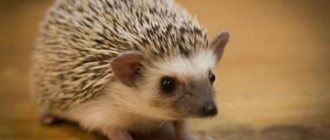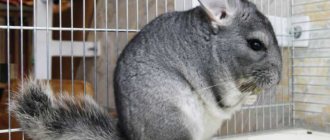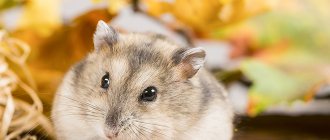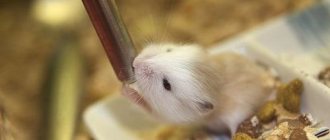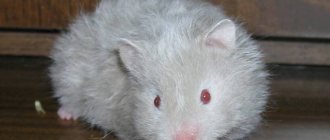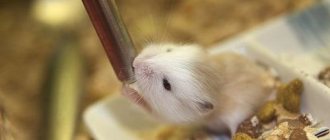For educational purposes, parents often entrust the care of their pet to their child. But children usually don’t know how to care for a hamster correctly. Such a careless attitude often leads to illness or premature death of the animal. Therefore, owners need to study all the information about it and read the recommendations of experienced breeders regarding keeping hamsters.
What types of hamsters are there?
Rodents vary in color, size and coat type. There are five types of domestic hamsters in total. Their standards, The National Hamster Council, are set by the National Association of Hamster Fanciers of England.
Syrian hamster
This is the largest Syrian Hamsters from home. The average length of its body is 13 cm. Females are sometimes larger than males.
The classic color of the Syrian hamster is golden brown. There is black ticking on the back - this means that areas of different colors alternate on the hairs. The animal's belly is white with gray undercoat, and there are dark spots on its cheeks.
Individuals of other colors are often found: white, cream, brown, black, gold, silver-gray, striped.
Hamsters of this species can have different coats. There are four types in total:
- Short . The soft fur fits snugly to the body.
- Long . The length of the hairs is from 7.5 to 10 cm.
- Rex . The fur appears tousled.
- Satin . The hair has a glossy shine. It is not recommended to crossbreed two hamsters with such hair, because sometimes the offspring will be bald.
Syrian hamster with classic color. Photo: Olena Kurashova / Shutterstock
Campbell's Russian Hamster
The body length of such a rodent, Dwarf Exhibition Standards, is 10–12 cm. There are three main colors of the animal:
- Normal . The hairs on the back are brown. The belly is white with gray undercoat. The eyes are black.
- Argenta . The top layer of wool is orange-sand, the bottom is smoky-gray. The eyes are red.
- Albino . These are completely white pets with bright pink eyes.
Hamsters with gray, beige, black and chocolate fur are considered non-standard.
Campbell's Russian hamster with normal color. Photo: softkrafts.live.com/Depositphotos
Djungarian hamster
This Dwarf Exhibition Standards animal is sometimes called the Russian white dwarf hamster. Its body length is 8–10 cm. All pets of this species have a black stripe on their backs. There are only three colors:
- Normal . The body is dark brown, with black ticking on a third of the hairs. The paws and belly are white, and the ears are gray.
- Pearl . The rodent's fur is white.
- Sapphire . The fur on the back is smoky gray with a blue tint, the belly is white.
Sapphire colored Djungarian hamster. Photo: Faifarris4746/Shutterstock
Chinese hamster
This rodent looks like a mouse without a long tail. Its body length is 10–12 cm, weight is 45–50 g. There are two main colors of the Chinese Hamster animal:
- Normal . The back and sides are brown with a chestnut tint, the belly is white. A black stripe stretches from the forehead to the tail.
- Spotted . Most of the fur is white. There is an elongated brown spot along the spine.
Albinos with black eyes are extremely rare. They come in litters from spotted parents. But this is the exception rather than the rule.
Chinese hamster with normal color. Photo: alexvey/Shutterstock
Roborovsky's hamster
The smallest of domestic rodents. It weighs only 20–25 g, and its body length is 4.5–5 cm. Typically, these animals have golden-brown fur on their face and back. The roots of the hairs are gray, and there are light spots near the eyebrows. But very rarely there are hamsters with a white muzzle.
Roborovsky's hamster. Photo: Anyarnia/Shutterstock
Who are they?
In simple terms, hamsters are animals of the subfamily of rodents of the hamster family. They differ from their close relatives of mice in their small build, short tail process, small and rounded ears, as well as cheek pouches in which individuals of this species store and carry food.
The external characteristics of hamsters can vary significantly depending on the variety. Approximate description: body length from 5 to 30 centimeters, weight from 30 to 500 grams. Thanks to breeding research, the color is also varied - from solid white, blue, black and red shades to brown flowers with an original pattern on the back or chest.
In their natural environment, representatives of this breed can be found in many regions of Eurasia, China and Korea. These animals live mainly in open spaces of steppes and deserts.
Unlike their relatives, some types of hamsters can be trained and trained. In addition, like many other animal species, hamsters are capable of hibernating during periods of cold and lack of food.
What is the character of hamsters?
Rodents are active and curious Providing a Home for a Hamster. Animals are interesting to watch when they play in a cage. If a pet has been accustomed to communicating with a person since childhood, it can calmly sit in your arms. Hamsters rarely bite All About Syrian Hamsters: mainly when they are frightened by a sudden movement. Before communicating, for example, with Syriac, it is recommended to wash your hands. He has poor eyesight, so he relies on smell and touch. If the owner's fingers smell of food, the animal can taste them.
It is not worth keeping individuals in pairs. Even when they live together from an early age, conflicts can arise over time.
If you are still going to buy several animals, it is better to place them in different cages.
Keep in mind that rodents are nocturnal. They sleep during the day, so it is better to play with them in the evening. If you decide to wake up your All About Syrian Hamsters pet, do it very carefully. Talk to him in a gentle voice and lightly rustle the bedding in the cage.
Features of reproduction
In hamsters of any species, the period of maturity begins quite early - in some cases, already after reaching the age of one month. If breeding is not obligatory or urgent for you, then it is recommended to wait up to 5 months. It is at this age that hamsters reach full sexual maturity.
For mating, you should choose active and strong males, as well as healthy and energetic females. The mating itself should take place on neutral territory for each individual, only in this case it will not bring discomfort to the individuals. The best time for mating is in the evening. It is in the evening that the animal’s energy increases, as does sexual activity.
If mating was successful, within a week you will begin to notice characteristic signs of pregnancy: swelling of the nipples, weight gain, decreased activity, the need for more water and food, and possible irritability in the female. Approximately 3-4 weeks after mating, cubs are born; there can be from 1 to 15 or even 18 in a litter, depending on the variety.
Over the course of a year, the average female is capable of bearing litters up to 3-4 times; these animals are extremely fertile.
To save the young, the male should be placed in another cage immediately after birth, otherwise he may simply eat the young individuals. The female should be treated with extreme caution during the period of feeding and rearing. Try not to irritate the animal with games and entertainment; at this time the female needs peace and a large amount of vitamins more. The cubs can be moved to another cage when they reach one month.
What living conditions does a hamster require?
It is best to house your hamster in a spacious wire cage, Choosing a Dwarf Hamster Cage. The minimum floor area is 60 × 30 cm. A plastic tray is considered a good option. But grated flooring is not suitable: your pet will easily injure its paws on it. The door of the home must close tightly. The distance between the rods is no more than 5 mm. Otherwise, the rodent may escape.
If you choose a multi-level design, pay attention to the height of the floors. The lower they are, the better. Then, when falling, the animal will not be seriously injured.
A pet store may offer you a plastic cage with pipes. Keep in mind: it will not provide adequate ventilation. In addition, it will be difficult to clean.
Hamsters are susceptible to cold and heat. They feel best at a temperature of 18–21 °C The ideal home for your hamster. Therefore, the cage is usually placed away from drafts, radiators and direct sunlight. If the room is too cold, the animal may hibernate. Loud sounds and vibrations cause stress in rodents. Therefore, it is worth finding a calm and quiet place for the house. There should be no TV or music system nearby.
Be sure to place a ceramic bowl inside the cage How to Care for Your Pet Hamster, and pour water into the nipple drinker.
A large layer of bedding should be laid on the pallet of the dwelling. Animals love to rummage in it. If you want to go with wood How to Care for Your Pet Hamster litter, choose aspen. Cedar and pine irritate the respiratory tract of hamsters.
The cage should also have shelter. The pet will rest there. If desired, you can buy a wooden or plastic house. Some owners use cardboard boxes. They wear out quickly, but are easy to replace.
Running wheel without cross supports. Photo: PetroP/Depositphotos
A hamster definitely needs a large running wheel. Try to find something that attaches to the cage. Typically, such models do not have transverse supports on which the animal can damage its paws. If you are a light sleeper, choose a quiet design.
To grind down the teeth that hamsters constantly grow, you will need wooden toys from Pet Hamster Toys. But some owners simply give their pets toilet paper or towel rolls instead.
Inventing entertainment
Of course, the hamster always has a lot to do in his cage, but sometimes he needs some extra entertainment. You can buy him toys or make him a real amusement park that you can use while walking.
Prepare:
- several toilet paper tubes and paper towels;
- empty plastic bottles;
- empty cardboard boxes of different sizes;
- cardboard;
- cardboard scissors or linoleum knife.
How to build an amusement park?
First, think about what it will look like. Lay out all the materials on the floor or make a sketch. Now start assembling.
Make a slit in the center of one of the pipes. Connect some of the pipes to each other, and insert some into boxes. Cut round holes in the top of some of the tubes. They are needed so that the hamster can stick out of the holes. Close the system of pipes and boxes to each other.
Make sure that there is enough space in the pipes for the animal - otherwise it will not fit there.
Don't forget about safety!
- Look for boxes that are missing writing or graphics. The animal will probably gnaw on them, and the paint may give you a stomach ache.
- Do not use glue or tape. They can stain fur and are very dangerous if ingested.
- If you don't want to bother with cardboard, assemble the entire structure from plastic. Sections of sewer pipes are excellent for this purpose. They are easy to attach to each other. Show your imagination, and your pet will definitely thank you.
For the convenience of walking your hamster outside, you can purchase a hamster leash.
What to feed a hamster
The majority of the diet should be prepared food What Can Hamsters Eat? , for example crumbly mixtures. They contain grains, seeds and dried vegetables. The disadvantage is that hamsters pick out the tasty morsels. Less tasty but healthy additives often remain in the bowl. Therefore, you need to make sure that the animal finishes everything. If you have no time to control your diet, it is better to choose granulated food.
Hamsters can also be given human food, but its amount should not exceed 10% of the diet. Here are examples of safe products:
- Vegetables : broccoli, carrots, cauliflower, cucumber, potatoes (cooked), spinach, cabbage.
- Berries : grapes, blueberries, strawberries.
- Legumes : young beans and peas, dry or steamed lentils, unsalted peanuts.
- Fruits : apples (without seeds), bananas.
Animals are also sometimes given hay, dandelion leaves, crickets and mealworms.
You cannot feed your hamster citrus fruits, raw potatoes, apple seeds, dry peas, onions, garlic, almonds, sweet and salty foods.
Interesting Facts
It is worth considering the list of 15 most interesting and funny facts about hamsters, which have been collected for you from around the world. Some of the information from the facts applies only to some varieties of these animals.
- The largest breed of hamster in the world is the European hamster. Representatives of this breed can grow up to 35 centimeters in length.
- The smallest variety is the dwarf hamster. Its length rarely exceeds 10 centimeters.
- The main activity of hamsters occurs at night and at dusk. During the day, they prefer only to hoard food or play.
- Hamsters are considered omnivores, as they are able to digest not only plant, but also animal food.
- The buccal sinuses of hamsters serve not only for dragging food (up to 30% of the animal’s weight), but also for successful swimming. The animal takes air into its cheeks, which allows it to float freely.
- The coloring of hamsters can be completely different, some researchers count up to 40 separate colorings, including white, red and black shades.
- The most common 4 breeds of hamsters are the Syrian golden, Djungarian, Campbell's hamster and Roborovsky's hamster. The most commonly bred variety is the Syrian golden variety. They are the ones that can most often be found at home.
- Some species of hamsters are actually on the verge of destruction, while other species are considered by some countries to be real pests, from which entire hectares of vegetable crops (especially legumes) suffer. The rarest varieties of hamsters are the Syrian hamster and Newton's hamster.
- Most species of hamsters do not have good eyesight, and in addition to this, these animals are color blind. However, hamsters' sense of smell and hearing are simply remarkably developed, which helps them quickly find food in their natural environment.
- The average lifespan of hamsters is 1.5-2 years. Moreover, 1 year of existence for this animal is actually equal to 25 years of human life.
- The word hamster is translated from the ancient Avestan language as “an enemy who throws down.” Researchers believe that this was due to the animals' habit of bending plants under themselves to get to food or fruit.
- Hamsters, like squirrels, always store much more food than they can consume. You should be prepared to discover a whole warehouse of food if you haven’t thoroughly cleaned the cage for a long time.
- In some countries, for example, in Vietnam, it is officially prohibited to keep hamsters at home. These animals are considered not so much pests as carriers of deadly diseases. Failure to comply with this law results in a steep fine of approximately $800.
- Oddly enough, hamsters are a rare breed of animals that are born with incisors, which continue to grow throughout their lives.
- Dwarf hamsters, as well as some other varieties of hamsters, are able to slightly delay the birth of young animals if at the same time the female is raising cubs from an earlier litter.
How to care for a hamster
To keep your pet healthy, you need to regularly clean its cage. Do this in the evening The ideal home for your hamster, when the animal is awake. Dispose of How to Clean a Hamster Cage stale food scraps from bowls every day. Pour clean water into the drinking bowl. Remove feces and wet areas of litter.
If your home looks clean, but it smells bad, you need to replace the filler completely. Sometimes rodents bury food in it, which eventually begins to rot.
Do general cleaning once a week. All you need is a sponge and a non-toxic disinfectant from a pet store. The latter can be replaced with mild hand soap: aggressive chemicals are poison for your pet. When everything is ready, remove the hamster from the cage and place it in a safe place. Don't forget to keep an eye on him. Thoroughly rinse the structure, bowls, running wheel and other accessories. Make sure everything is dry before putting it back in place.
Accessories
To make your pet comfortable, it is advisable to arrange his life. To do this, you can purchase accessories for hamsters at a pet store. Their selection is varied.
Pet house
The hamster will appreciate such a shelter. He will be happy to put his supplies there.
The houses are ceramic, plastic, and wooden.
Running wheel
Under natural conditions, hamsters have to run a lot.
To maintain good physical shape, you can purchase a wheel.
For adult large animals, the diameter of the structure should be 18 cm, and for small animals – 14-16 cm.
Exercises will help the hamster avoid obesity and cheer him up.
Drinker and feeder
The feeder should be ceramic. This will make it difficult for your pet to turn it over. Access to water must be ensured at all times.
Tunnels
If the animal is tired of running in a wheel, a tunnel is installed. You can create labyrinths.
Your pet hamster will be happy to move around it.
Hammock
You can buy something like this for your pet. The hamster will rock and rest a little.
walking ball
A hamster walking ball will help him move around the apartment safely.
It will diversify life and satisfy the curiosity of a small animal.
Toilet
You can purchase a corner toilet. It will make the task of cleaning up after your pet easier.
Sand bath
You can install a sand bath for bathing.
Carrying
A necessary thing if you take your pet with you on short trips, for example to the country house.
Carrying it in your pocket is dangerous. The animal may jump out and get hurt.
Filler
At the bottom of the cage you need to pour a layer of filler 2-3 cm thick. You can use finely torn paper.
Just not newspaper, as printing ink can cause digestive problems for your pet.
You can purchase wood filler. It absorbs odor well.
Some cage models are sold with accessories (drinker, wheel, ladder).
What do hamsters get sick with?
Hamsters are fragile animals. Any injury or illness can seriously affect your health. You need to know about potential problems at Hamster Health and Diseases in order to take your animal to the veterinarian in time.
Abscesses
These are bumps filled with pus. They form under the skin and mucous membranes and can even appear due to minor cuts or scratches. If your hamster constantly looks like he's got food in his mouth, take him to the vet. There may be an abscess in the cheek pouch. The doctor will remove it and prescribe antibiotics.
Respiratory infections
You can suspect them if the animal sneezes frequently and fluid leaks from the nose and eyes. Problems are also indicated by wheezing, difficulty breathing, loss of appetite and laziness.
Enteritis
Some call this deviation "wet tail." Symptoms include diarrhea, loss of appetite, ruffled fur and lethargy (decreased activity, prolonged sleep). The disease is deadly. It most often occurs in hamsters that have recently been weaned from their mother.
Skin diseases
These are ringworm, fur mites, fungal and skin infections, allergic dermatitis. Take your pet to the vet if he itches frequently. The disorder can also be determined by peeling and redness on the skin.
Diseases and their prevention
Unfortunately, any type of hamster is extremely vulnerable to many colds and infectious diseases. Some of these diseases extremely weaken the animal's body, which can ultimately lead to its death. Including a certain part of the diseases will be caused by improper conditions of detention, and not by the breed characteristics of the species.
Remember that the best medicine for your pet is timely contact with an experienced veterinarian, avoid self-medication.
We list the most common ailments of hamsters.
- Obesity . A common disease among all pets. The reasons are irregular and plentiful feeding together with a sedentary lifestyle. That is why keeping hamsters requires a lot of free space for games and entertainment. In their natural habitat, these animals spend about 90% of their active life in constant motion. Obesity can become a breeding ground for the development of many cardiovascular diseases.
- Abscesses on the limbs . A disease that occurs as a result of high activity and improper nutrition of an animal. To cope with the symptoms, you should regularly smear wounds and abscesses on the paws with zinc ointment or fish oil. Healing will not take place immediately, in some cases you will have to wait up to six months.
- Enlarged or bent incisors . Half of the animal's diet should be solid food, which will grind and form the animal's teeth. This is especially important for still young individuals whose teeth have just begun to form. Symptoms of the disease include excessive salivation and loose mouth closure. You cannot shorten teeth at home; there is a high chance of harming the animal even more.
- Escherichia coli. The main danger for any type of hamster is gastrointestinal diseases. Symptoms of the stick are fever, as well as bloody diarrhea. The animal, as a rule, does not survive in this case. The disease occurs due to a sudden change in diet, as well as due to poor living conditions - dirt, unwashed cage, expired food, dirty water.
- Colds. The disease occurs with similar symptoms as in humans: cough, runny nose, sneezing, discharge from the eyes. You should fill the diet with plenty of fresh vegetables and fruits, and also provide your pet with a dry and warm corner without drafts or cold.
- Cystitis. The disease occurs due to a lack of vitamins, as well as being kept in damp and cold conditions. Symptoms include frequent urination, lack of appetite, and external agitation. Most often, sulfonamides and Buscopan help in this case, however, if treatment does not help, it is worth taking an x-ray. It is possible that your animal has bladder stones.
- False rabies or, in other words, Aujeszky's disease. In this case, a certain virus attacks the pet’s nervous system. The first symptoms begin to appear within a week - the animal behaves restlessly, itches, and squeaks. If the disease is detected at this stage, it can still be prevented. At the final stage, the animal’s vocal cords completely lose activity and oral paralysis occurs. Then death comes almost immediately.
- Skin diseases: abscesses, peeling, itching, ulcers, abscesses, hair loss. These diseases can be caused by infection, parasites, or poor nutrition.
These are not all diseases in hamsters. To more accurately determine the diagnosis of your pet, do not be lazy to contact a veterinarian as soon as possible.
Choice when purchasing
When buying a hamster, it is quite difficult to settle on just one individual, since each of them will cause affection. To understand the true nature and type of higher nervous activity of a rodent before purchasing, you need to start purchasing it in the afternoon, when the animal is in wakefulness mode. In this case, the potential owner will be able to see all the advantages and disadvantages of his pet.
Hamsters are solitary animals and never live in packs; when buying an animal, you should not look for a mate. If you plan to keep more than one individual, it is advisable to take rodents from the same litter, or young ones. This is especially important if the decision is made to purchase two males.
An important point is to study the hamster for diseases. A sick individual is distinguished by the following signs:
- dull, tousled fur;
- noticeably sunken sides;
- paw tremor;
- red eyes and signs of runny nose;
- traces of smeared feces in the anus;
- hoarse breathing;
- general body trembling.
A healthy hamster is always cheerful and cheerful, its body is symmetrical without bumps or depressions, its coat is smooth and shiny, its eyes are clear, and its nose is without signs of a runny nose.
Ensuring activity
Keeping hamsters in tiny cages or a three-liter jar is cruel to the animal, which in nature runs several kilometers every day. It’s not for nothing that their home is equipped with a running wheel. Caring for hamsters may include providing them with leisure time. The owners set up entire playgrounds, labyrinths and tunnels for curious rodents.
Despite the need for movement and variety, you can only let your pet out for a walk around the apartment in a walking ball. Otherwise, the hamster at home is in mortal danger - it can get stuck, be crushed/pinched by a door, fall, fall into a pan, eat a poisonous plant, or chew through an electric wire. Catching a pet can be very difficult.
You cannot organize a walk on high surfaces (table, sofa). All hamsters come from the lowland steppes; they do not understand and are not afraid of heights. There is a high risk that the pet will fall.
Is it possible to walk a hamster outside?
With the best of intentions, some owners strive to let their pet spend time in nature. But the pet hamster will not receive pleasure from such a walk, but extreme stress. Not many people think about the fact that a pet can become seriously ill.
In nature, the animal is in wait for predators: dogs, cats, rats, crows. A nimble baby can easily run away and get lost forever. The outdoor environment is more aggressive and unstable: the hamster can become hypothermic, especially if the grass is wet, or overheat in the sun. The soil and grass are often infested with parasites and are a source of infection due to wild rodents.
Treatment
You can relax here. You won't have to vaccinate your hamster; you'll save your hard-earned money on vaccinations and veterinarian fees. Firstly, these rodents rarely get rabies. Secondly, vaccinating an animal that lives only two or three years is simply not profitable and pointless. Virus-resistant antibodies simply do not have time to be developed in the hamster’s body during its short life.
But you cannot do without treatment completely. The rodent may develop parasites - worms and fleas. To make your animal feel comfortable, you will have to buy a special powder and treat it. This powder costs about 100 rubles, and it won’t last a hamster’s entire life.
Of course, rodents sometimes get more seriously ill. But in each specific case, you need to consult a veterinarian, who will prescribe the appropriate treatment, the cost of which can be found out directly at the veterinary clinic.
Communication
Hamsters are far from the most sociable rodents, since in nature they live strictly alone. At home, keeping a hamster should also be solitary; if there are several animals, then there should be several cages. Such a pet also does not strive to communicate with the owner, so you will have to spend a lot of time taming an independent rodent.
There are certain rules of communication; if they are not followed, the hamster will show fear and aggression, irritating the owner. In the first days after purchasing the animal, it is better not to disturb it at all, no matter how much you want to cuddle the fluffy little ball. It will take about a week to get used to the new home, and at the same time to the voice and smell of the owner. At this stage, it is recommended to say your pet's name while feeding .
Domestic hamsters differ little in temperament from their wild counterparts; they must be patiently trained to be handled so that communication brings joy to both the owner and the pet. With hamsters, the main remedy is food reinforcement - you need to teach the baby to take a treat from the palm of your hand. Gradually the rodent will get used to the hand, then it can be pulled out of the cage. Handle the animal with care - the tiny animal can be injured if it jumps out of your hands or is held too tightly. The safest thing to do is to wrap your palms around it, forming a “house”.
Contraindicated:
- wake up the animal;
- take from above, from the back (association with a predator attack);
- make sudden movements (even if bitten, you need to remain calm).
Caring for your hamster should include daily interaction. If you do not pick up your pet for a long time, a “rollback” will occur, and taming will have to start again. Contact should occur when the animal is active (in the evening).
Toys for grinding teeth
A hamster's teeth require constant care. If the food it eats is not hard enough, the animal’s teeth quickly grow and begin to interfere with its eating.
Overgrown incisors can accidentally damage the rodent's gums, tongue, or lips. As a consequence of this, the animal stops eating and begins to starve. Only a veterinarian can correct this situation, and it can be prevented by giving the animal a variety of things to chew on, preferably wooden or rubber objects.
Proper house equipment
Having chosen a suitable home for your hamster, you should definitely equip it with:
Read also: Fashionable women's oversized sweater
- You need two feeders for rodents. Dry grainy food will be poured into one of them, and natural food in the form of fruits, vegetables and other delicacies will be poured into the other. It is not recommended to place the feeder on the floor. It is best to secure them to rods.
- It is better to choose a nipple drinking bowl for a rodent. It is a closed container with a ball-shaped nipple. To drink, the hamster will have to press the ball with its tongue. In such drinking bowls the water will always be fresh and clean. If you put an ordinary cup, a restless pet can easily knock it over . As a result, the floor in his home will always be wet. In addition, in open containers, water quickly becomes contaminated with food, excrement and various debris.
- Hamsters prefer to sleep in burrows, which can be made from corn filler or sawdust. As a last resort, you can use old newspapers or toilet paper. Materials that absorb unpleasant odors should be used. Therefore, it is not recommended to use rags and cotton wool.
- a place for the toilet himself. When caring for a pet, its toilet will need to be cleaned daily, since the rodent will not relieve itself in a dirty place, and will look for another area for this. As a result, his entire house will be dirty.
- Hamsters are very active, so their cage should be equipped with a running wheel. You can buy such a device at a pet store. You should choose a plastic product, since iron rods can injure your pet’s paws. If there are only wheels with iron bars, then they are covered with cardboard.
- The hamster's house should have a mineral stone, which is an additional nutritional element. The rodent will use it to clean and sharpen its teeth, while simultaneously receiving minerals for its body. The stone can simply be placed on the floor of the cage or tied to the bars.
Hygiene procedures
Like other furry pets, the hamster needs hygiene procedures. Long-haired individuals require daily care. It is important to regularly clean the skin from dirt.
Bathing
You can bathe pets only in exceptional cases, using a special shampoo. Water procedures are a stressful situation for animals, since they are quite clean and constantly wash themselves.
It is recommended to place a container with dry sand in the cage, in which the animal will clean its fur. When fleas appear, you should wash your hamster with an antiparasitic agent, applying it with gentle movements to the surface of the body.
Dry cleaning of fur.
Nail care
Particular attention should be paid to the claws. They need to be regularly ground down, because with a sedentary lifestyle and the onset of natural old age, they grow to such an extent that the hamster cannot walk normally.
Nutrition
The hamster, of course, does not eat much, and a package of special food will last you for a month. Don’t go cheap, cereals alone (90 rubles per package) are not enough for him - buy food that also contains nuts and dried fruits (230-250 rubles in Kemerovo pet stores).
In any pet store, in addition to regular food, you can buy hamster treats - cookies or various kinds of bars. But this is not necessary - “live” vitamins are no worse. We don’t include this in our expenses: after all, we buy fruits and vegetables for ourselves, which means that the hamster will also get it – how much does he need?
see also
Total
As Vladimir Mashkov , “let’s be like a grandmother”: on the day you buy a hamster you will have to spend at least 2,750 rubles. Its annual maintenance will cost you 17,140 rubles with corn as a filler, or 9,940 with hay. And that's the minimum. Now let's remember how much the hamster itself costs. Well, doesn’t he deserve to be called a “budget eater”? Another thing is that the costs, in our opinion, are worth it. The Djungarian hamster Pesha, who posed for this article, belongs to one of our editorial staff. And this employee assures that he does not regret a single penny spent, because in return the gray pet gives his family a sea of positive emotions.


